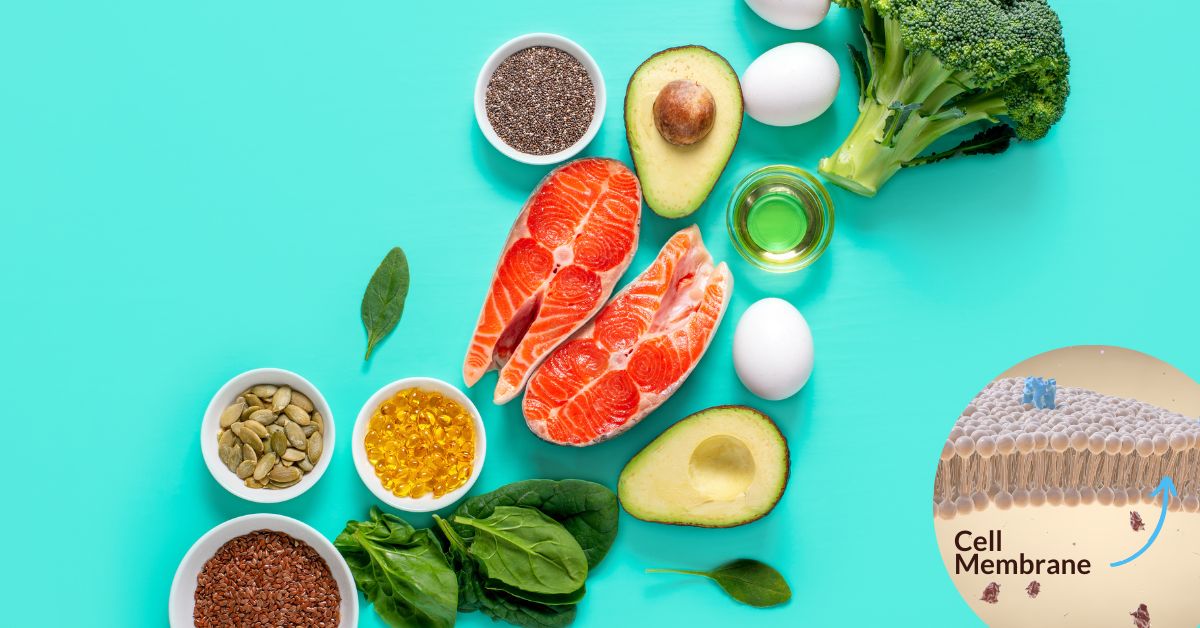|
If you were to peek through a microscope at the omega-3 and omega-6 fats, you’d see some pretty funky shapes, which are the manifestation of ‘kinks’ in their fatty acid structure. These kinky little fats don’t just look groovy, their kinked structure make them vital for health and proper brain, eye, cell, and immune system function (1). They also play an important role in early reproductive events including oocyte maturation and embryo implantation. So yeah, they’re a pretty big deal. The caveat: our bodies cannot ‘kink’ the omega-6 and omega-3 fats themselves, so we must obtain them from our diets, which is why we call them essential. You may have heard them called essential polyunsaturated fatty acids (essential PUFAs for short). Our bodies function optimally with a 4:1 or lower ratio of omega-6 to omega-3 kinky fats in our cell membranes (3,5). With the foods we often consume today, particular in Western cultures, omega-6 to omega-3 ratio is much higher at 10:1 to 50:1 (2,3). That’s a whole lotta omega-6 and a whole little omega-3. his is problematic, because omega 6 fatty acids have a strong pro-inflammatory effect, while omega 3 fatty acids are potent anti-inflammatories (4). In short, the further away your omega 6: omega 3 balance is from the optimal ratio, the more inflamed your body. Can Optimal Omega-6:Omega-3 Balance Improve my Fertility?Chronic low-grade inflammation is associated with infertility. Optimal omega-3 dietary intake dampens markers of inflammation and supports better sperm quality, is associated with improved egg health and increased pregnancy rate (6). Meanwhile, low intake of omega-3 fatty acids may reduce the chance of pregnancy (7, 8). Dietary omega-3 also has prebiotic effects on the gut microbiota, increasing the abundance of microbes that produce compounds supporting gut health (9), which we know is great for fertility ! What is My Omega-6:Omega-3 Ratio?These days finding out your omega-6:Omega-3 ratio is simpler than it’s ever been. Laboratories have developed test kits that you can complete in the comfort of your own home. Generally, the procedure looks something like this:
My Omega-6:Omega-3 Ratio is Higher Than the Optimal 4:1… What Do I Do?While your ratio might be higher than expected, you now have greater insight into your body. With this knowledge you can move towards an optimal omega-6:omega-3 balance for health and fertility. Some positive steps you may take include: 1. Increase your intake of omega-3 rich foods, particularly those from marine sources. Animal and Marine Sources: fatty fish (herring, wild-caught* salmon, rainbow trout, sardines), tuna, shrimp, yellow tailed king fish, cod, snapper, trevally, barramundi, dhufish, bream, whiting, squid, rock lobster, mackerel, seabass, mussels, scallops, crab, octopus, oysters, seal oil, omega-3 eggs, marine algae (*farmed salmon is also rich in omega-6, so this source alone may not provide you with the optima balance of omegas) Plant Sources: flaxseeds (linseeds), chia seeds, walnuts, spinach, brussels sprouts, blueberries, hemp seeds, kidney beans, tofu These plant sources are weaker sources of omega-3 compared to animal sources and marine algae, as the body’s ability to process them is inefficient. If you are vegan or vegetarian, we recommend supplementing with a quality marine algae oil – read step 3 for a definition of ‘quality’. 2. Lower your intake of omega-6 rich foods that aren’t balanced with some Omega-3s. High levels of omega-6 are found in cooking oils such as vegetable, safflower, sunflower, corn, soy bean, sesame and palm oil; fast food and ultra-processed foods are generally cooked in, and/or include an abundance of these oils. 3. Consider supplementing with an omega-3 + polyphenol blend Sometimes it’s just not possible to consume sufficient omega-3 intake from the diet, especially if wild caught fish is not accessible to you. In these instances, an effective, good quality supplement can be an excellent solution. Is My Omega Supplement Effective?In nature, omega-3 fatty acids are packaged with compounds called polyphenols. Omega-3 supplements containing polyphenols have been shown to enhance absorption of the omega-3 fatty acids by the body and preserve the anti-inflammatory properties of the supplement in addition to enhancing the antioxidant properties of the polyphenols (10). The presence of polyphenols also stops the omega-3 fats from going rancid (kinky fats have a very short shelf life). If you are going to take an omega-3 supplement, make sure it the source is good quality and it is packaged with polyphenols for optimal outcomes. It's All About BalanceA body able to effectively regulate inflammation supports fertility. Testing your omega-6 to omega-3 ratio provides valuable insight into inflammation and looking forward to healthy pregnancy progression. The World Health Organisation recommends an omega-6 to omega-3 ratio of 4:1 or less. If you would like to find out your omega-6, omega-3 kinky fat ratio, and receive personalised guidance and support for restoring balance, we would love to see you online or welcome you in the clinic! Written by Emily Hahn, APD References
Comments are closed.
|
|
1300 084 694
[email protected] Suite T36, 477 Boundary St Spring Hill, Brisbane QLD 4000 Fax. 07 3540 8164 Copyright © 2022
|



